打 CISCN 的时候正好碰上期中考试,预习高数去了qwq,最近才有时间整理一下这题的思路
拖入 IDA ,在字符串窗口明显看到 golang 程序的特征
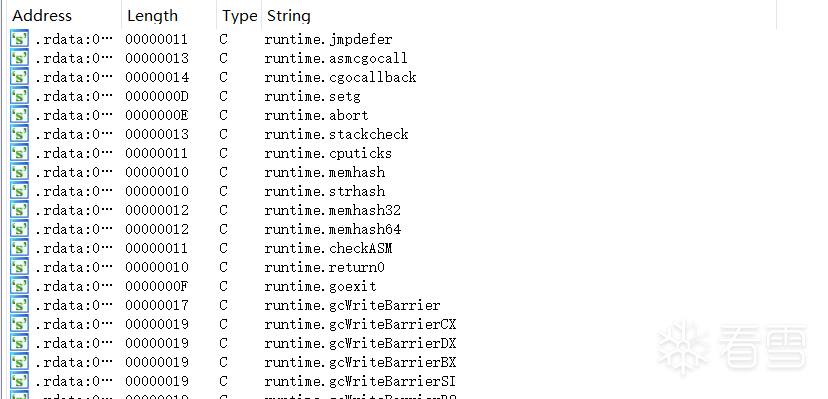
本以为又是普通的 strip 掉符号表(go build -ldflags "-s -w"),直接 IDAGolangHelper 莽就完了,没想到他直接给我上了一课

恢复失败了,顺着报错看看源码怎么说

提示 beg 是 NoneType,beg 是他的上层 renameFunctions 这个函数传进去的 gopc_lntab ,我们加个 print 打印出结果,果然是 None


getGopcln 函数尝试查找 exe 中 .pclntab 段,并返回段的地址,如果没查找到,就调用 findGoPcln 搜索 lookup 常数,找到以后调用 check_is_gopclntab 对数据结构进行检查,通过以后返回 lookup 常数的地址
所以问题就是,这个 exe 里,他没有找到 gopclntab ,经过疯狂百度,找到了安全客上一位师傅写的文章(https://www.anquanke.com/post/id/215419#h2-4),解释了 pclntab 的结构
pclntab 开头 4-Bytes 是从 Go1.2 至今不变的 Magic Number: 0xFFFFFFFB ;
第 5、6个字节为 0x00,暂无实际用途;
第 7 个字节代表 instruction size quantum, 1 为 x86, 4 为 ARM;
第 8 个字节为地址的大小,32bit 的为 4,64 bit 的为 8,至此的前 8 个字节可以看作是 pclntab 的 Header;
第 9 个字节开始是 function table 的起始位置,第一个 uintptr 元素为函数(pc, Program Counter) 的个数;
第 2 个 uintptr 元素为第 1 个函数(pc0) 的地址,第 3 个 uintptr 元素为第 1 个函数结构定义相对于 pclntab 的偏移,后面的函数信息就以此类推;
直到 function table 结束,下面就是 Source file table。Source file table 以 4 字节(int32)为单位,前 4 个字节代表 Source File 的数量,后面每一个 int32 都代表一个 Source File Path String 相对于 pclntab 的偏移;
uintptr 代表一个指针类型,在 32bit 二进制文件中,等价于 uint32,在 64bit 二进制文件中,等价于 uint64 。
所以上面查找的 lookup 常数就是 Magic Number 了,没找到的原因可能是 Magic Number被更换,或者 pclntab 的结构变了,可以用对照的方式找到这个出问题的 exe 中的 pclntab
我们再自己编译一个 strip 的 golang 程序,查找 0xFFFFFFFB

这里没开 PIE ,所以 .gopclntab 段的第一个结果就是我们要的 pclntab
我们找他的交叉引用,能找到包含指向 pclntab 指针的一个上层数据结构 moduledata ,再对 moduledata 交叉引用,有很多结果,我们取第二项
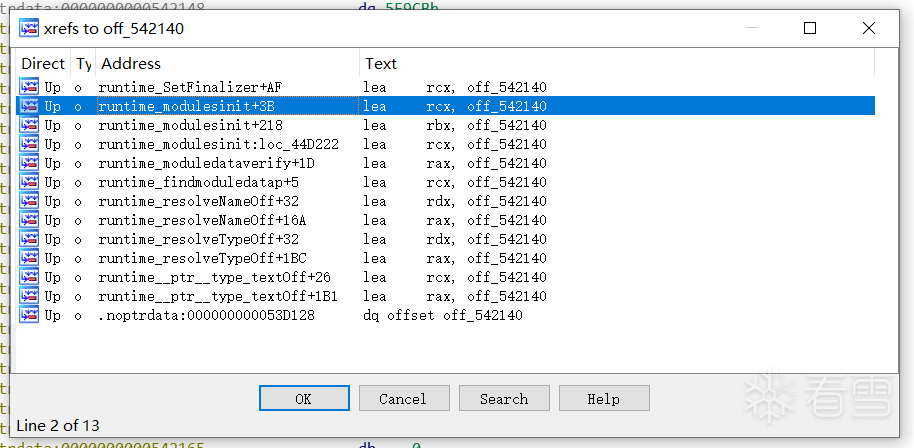
然后在出问题的 exe 中找到对应的函数,方法有很多,截取一段特征码去另一个 exe 里搜索(别选到跳转这些跟地址有关系的指令),也可以找到函数与入口点的调用关系。
确定这个函数在上一个函数里的位置就行了

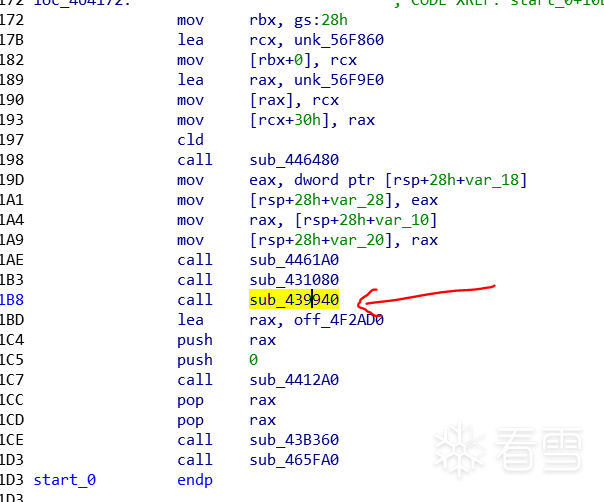
定位到 moduledata 和 pclntab
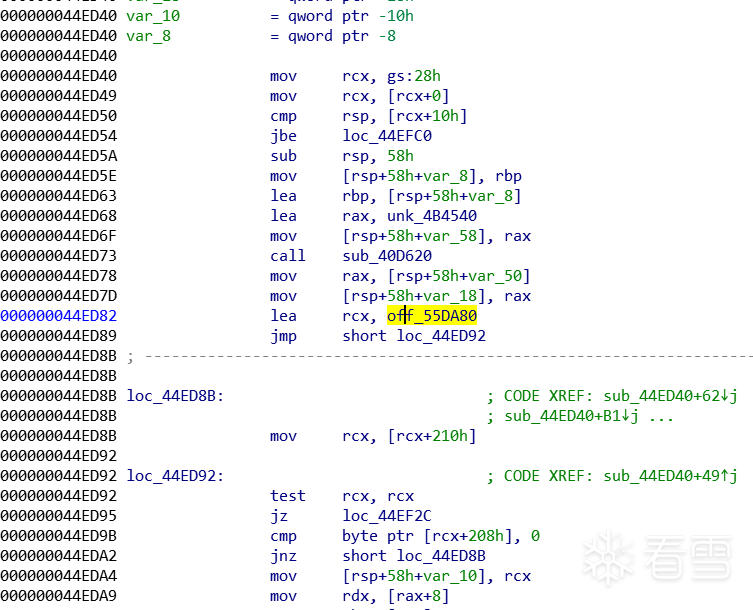
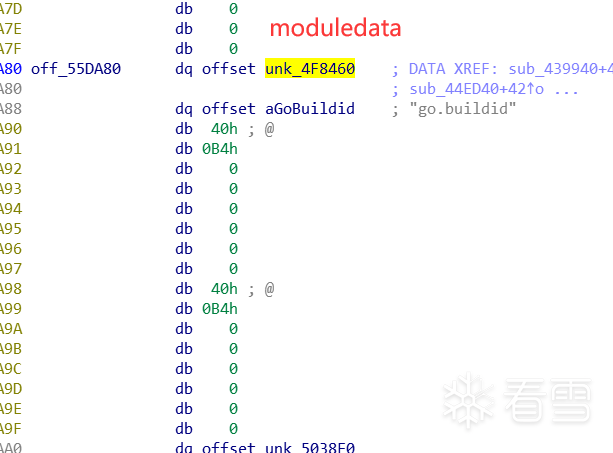
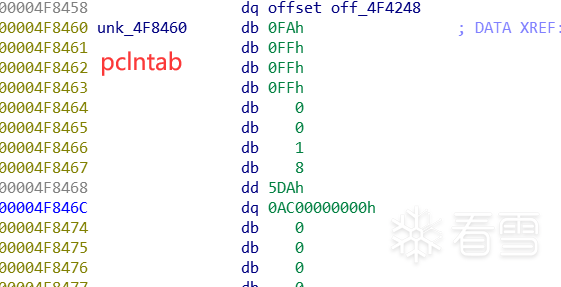
Magic Number 变成了 0xFFFFFFFA,而且结构的内容也变了,难道符号表被删掉无法恢复了吗
GO 语言中的很多机制都需要符号等信息(比如Stack Trace),所以函数名等信息应该还保存在 exe 中。可以从需要函数名的函数入手(比如Caller),分析函数名和地址的关系。

这是验证 moduledata 的一个函数,将 moduledata 传入 runtime_moduledataverify1
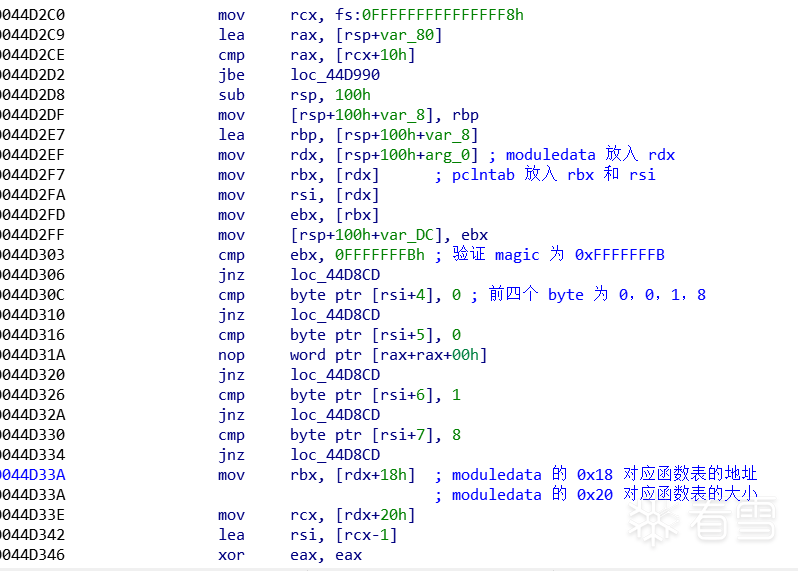
函数表 (func_table) 是这个样子的,两个元素为一组,即 (func_addr, func_struct_offset)
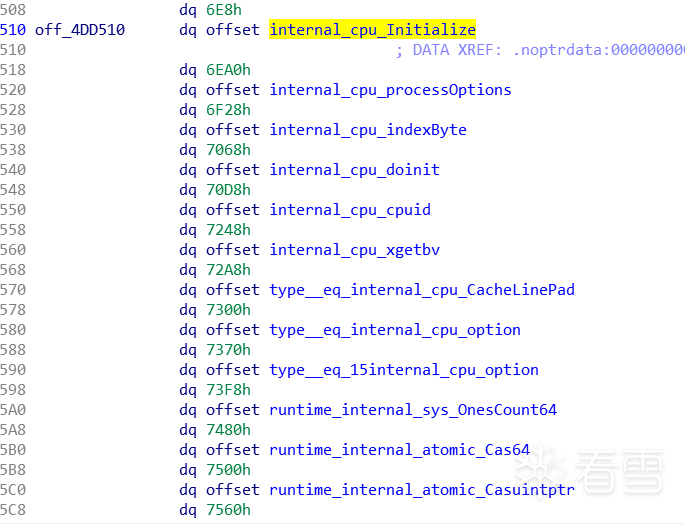
经调试可得知取函数名的操作在 runtime_moduledataverify1 的 runtime_funcname 中,runtime_moduledataverify1 中有对比 Magic Number 的指令 cmp ebx, 0FFFFFFFBh ,所以可以查找常数 0xFFFFFFFA 在题目文件中定位这个函数。
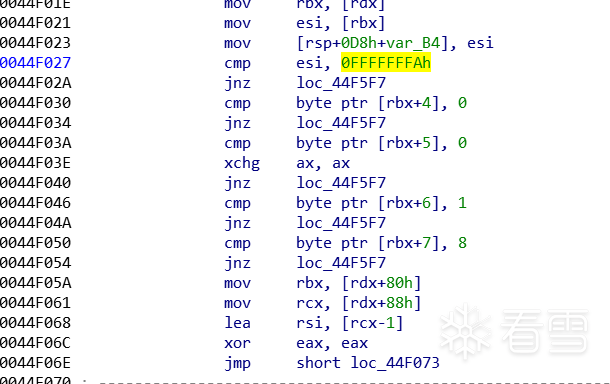
函数表在 moduledata 的偏移变成了 80h

Function Struct 在前面链接里的文章有提到


整理得到公式:
写个小脚本
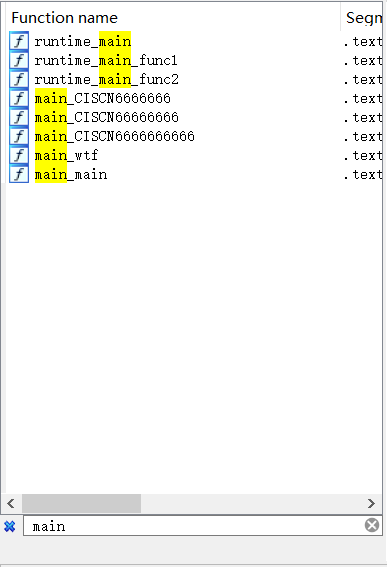
函数名终于出现了
双击运行,题目先输出一段 flag ,然后下一个字符的输出变得越来越慢,而且 CPU 占用很高(看来不是 Sleep 导致的),看来是要我们优化算法。
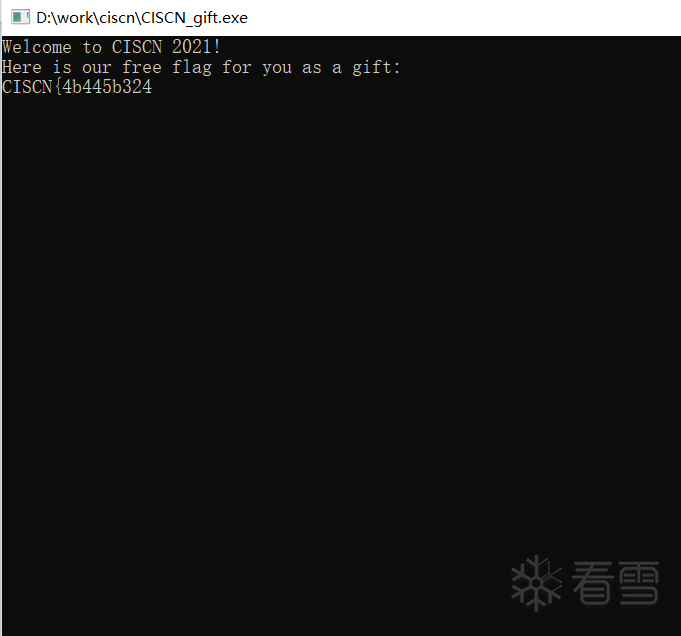
查看 main_main 函数
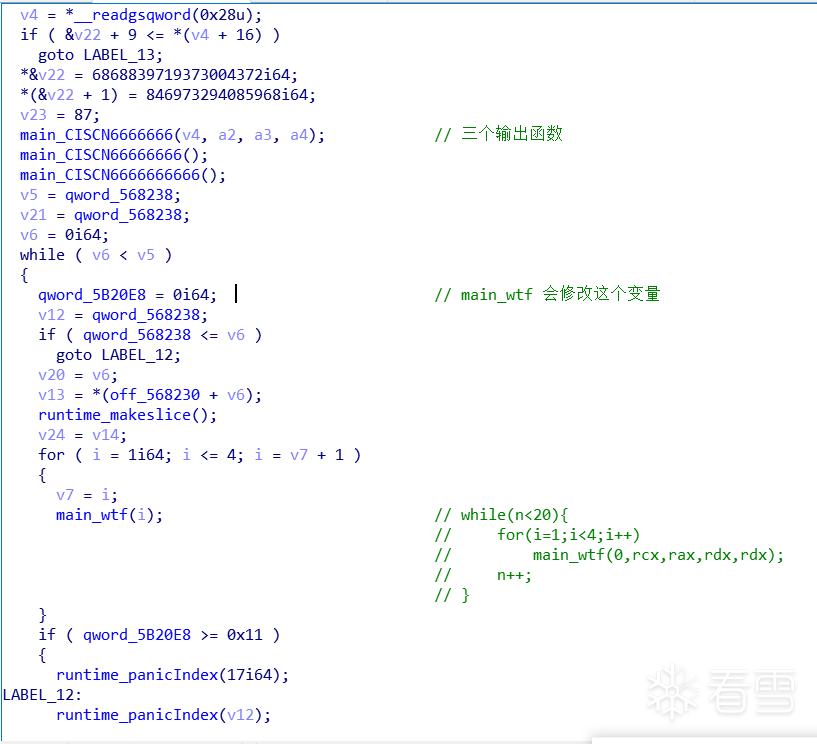
解密字符串,每一位异或 0x66 后再输出
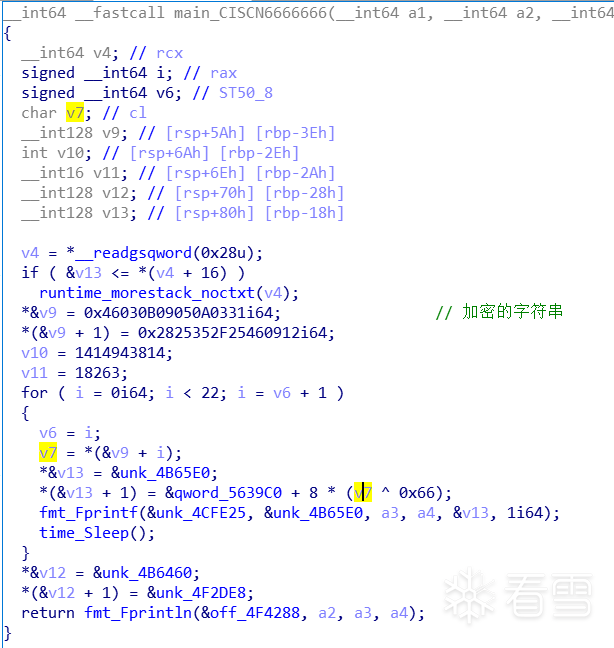
这里 IDA 的反编译结果是有问题的(因为 golang 使用栈传参,IDA 不能正确识别函数的参数,可以参考汇编)
每轮执行完 main_wtf 后,都会根据他的运算结果输出一个字符,追溯 rcx 那几个寄存器,可得到 main_wtf 的参数,main_wtf(0,i,slice_addr,slice_size,slice_size)
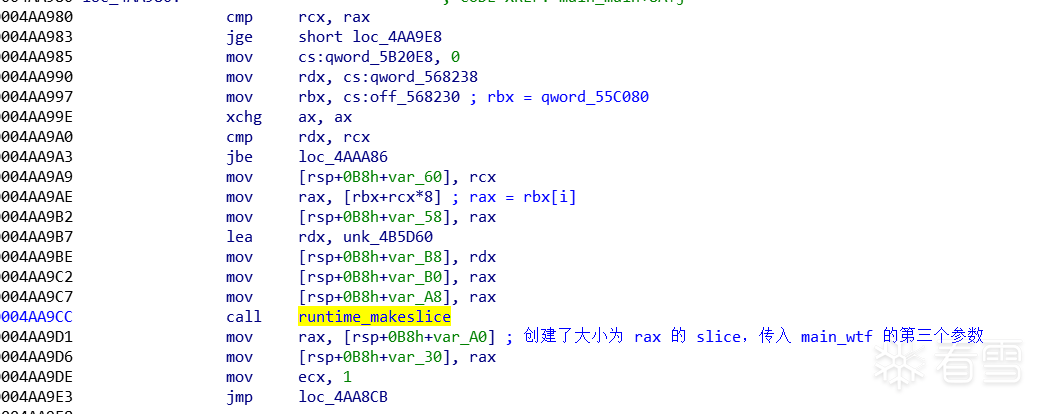
反编译 main_wtf
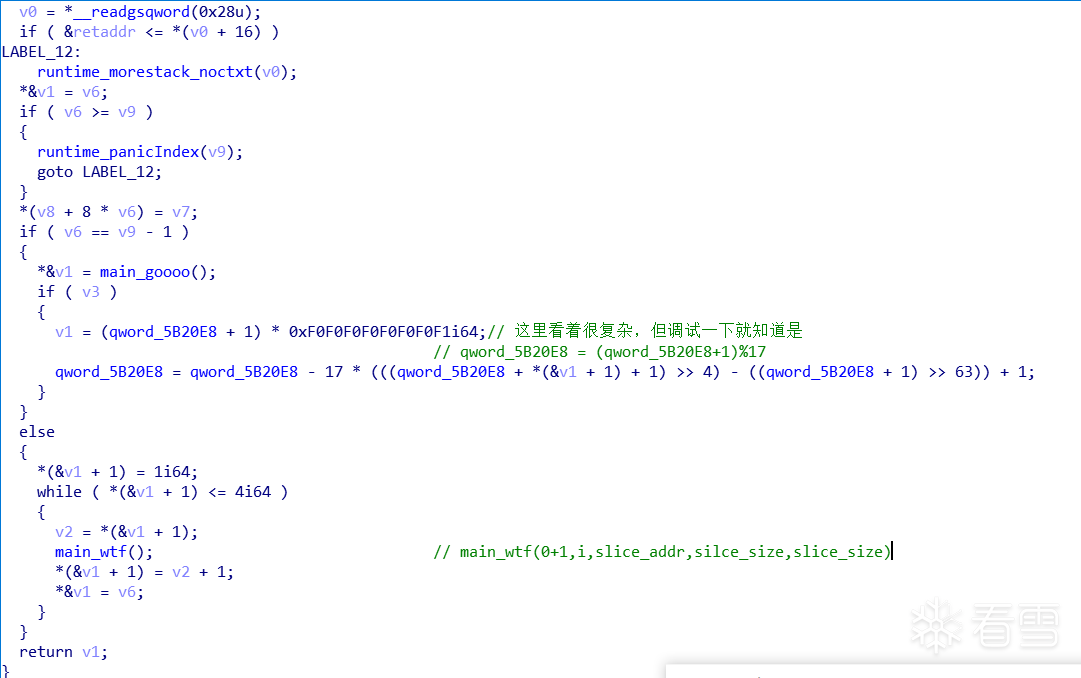
原来是递归,怪不得那么慢,再看看 main_goooo()
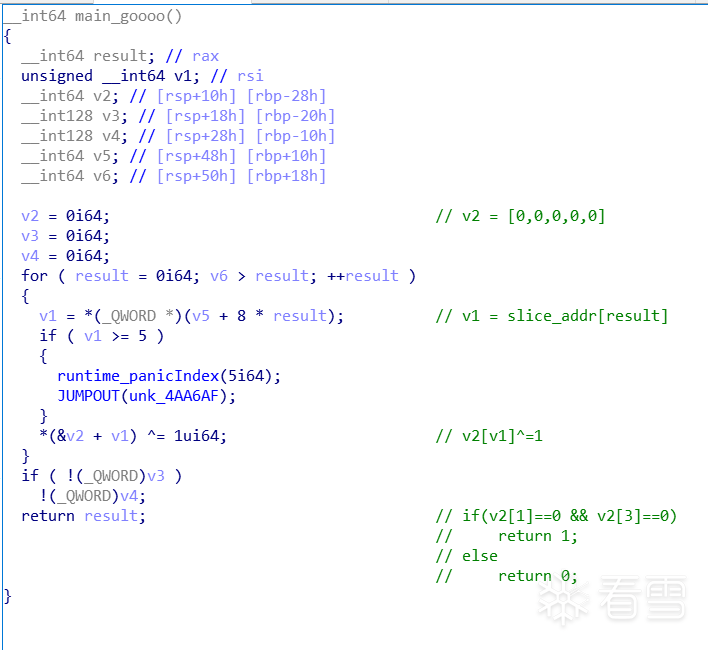
到这已经可以整理出输出 flag 的逻辑
因为跑后一个数据的时候,之前已经算出的结果还会重复计算,所以最开始想拿 unicorn 做一个记忆化,在用到已经算出来的结果时直接返回,但是后面的数据实在太大(比如 0x370D7470),递归这么多层肯定是不行的,还是分析一下吧。
读几遍代码发现,其实这个代码就是创建了一个 n 位数,然后使用递归把每一位填上1~4的数字,最后判断其中1和3的数量是不是偶数,可以用动态规划求解。
因为只有1~3的数量影响结果,所以每一个数字的情况可以分为四种:
偶数个1 偶数个3
偶数个1 奇数个3
奇数个1 偶数个3
奇数个1 奇数个3
而数字每增加一位,如果增加的是 1 或者 3,就把原来奇数个1 或者奇数个3 的情况变成偶数个1 或者偶数个 3,如果增加的是 2 或 4,奇偶情况不改变。
根据这个可以写出状态转移方程。
最后别忘了把计算结果映射成字符串

python 脚本:
得到 flag: CISCN{4b445b3247c45344c54c44734445452c}
lookup = "FF FF FF FB 00 00" if is_be else "FB FF FF FF 00 00"
lookup = "FF FF FF FB 00 00" if is_be else "FB FF FF FF 00 00"
_rt0_amd64_linux(entry point)->
_rt0_amd64 ->
runtime_rt0_go ->
runtime_schedinit ->
runtime_modulesinit
_rt0_amd64_linux(entry point)->
_rt0_amd64 ->
runtime_rt0_go ->
runtime_schedinit ->
runtime_modulesinit
struct Func
{
uintptr entry; // start pc
int32 name; // name (offset to C string)
int32 args; // size of arguments passed to function
int32 frame; // size of function frame, including saved caller PC
int32 pcsp; // pcsp table (offset to pcvalue table)
int32 pcfile; // pcfile table (offset to pcvalue table)
int32 pcln; // pcln table (offset to pcvalue table)
int32 nfuncdata; // number of entries in funcdata list
int32 npcdata; // number of entries in pcdata list
};
struct Func
{
uintptr entry; // start pc
int32 name; // name (offset to C string)
int32 args; // size of arguments passed to function
int32 frame; // size of function frame, including saved caller PC
int32 pcsp; // pcsp table (offset to pcvalue table)
int32 pcfile; // pcfile table (offset to pcvalue table)
int32 pcln; // pcln table (offset to pcvalue table)
int32 nfuncdata; // number of entries in funcdata list
int32 npcdata; // number of entries in pcdata list
};
string_addr[i] = *(moduledata+8)+ *(func_struct+8)
func_struct = *(func_table+0x10*i+8)+func_table
func_table = *(moduledata+0x80)
string_addr[i] = *(moduledata+8)+ *(func_struct+8)
func_struct = *(func_table+0x10*i+8)+func_table
func_table = *(moduledata+0x80)
moduledata = 0x55DA80
func_table = Qword(moduledata+0x80)
func_table_size = Qword(Qword(moduledata)+0x8) * 0x10
string_table = Qword(moduledata+0x8)
start_addr = func_table+0x8
end_addr = start_addr + func_table_size
while(start_addr<end_addr):
func_struct = func_table+Qword(start_addr)
func_entry = Qword(func_struct)
string_addr = string_table + Dword(func_struct+8)
print 'renaming '+hex(func_entry)+' to '+GetString(string_addr)
del_items(func_entry, ida_bytes.DELIT_SIMPLE,1)
add_func(func_entry)
set_name(func_entry,GetString(string_addr),SN_NOCHECK)
start_addr += 0x10
moduledata = 0x55DA80
func_table = Qword(moduledata+0x80)
func_table_size = Qword(Qword(moduledata)+0x8) * 0x10
string_table = Qword(moduledata+0x8)
start_addr = func_table+0x8
end_addr = start_addr + func_table_size
while(start_addr<end_addr):
func_struct = func_table+Qword(start_addr)
func_entry = Qword(func_struct)
string_addr = string_table + Dword(func_struct+8)
print 'renaming '+hex(func_entry)+' to '+GetString(string_addr)
del_items(func_entry, ida_bytes.DELIT_SIMPLE,1)
add_func(func_entry)
set_name(func_entry,GetString(string_addr),SN_NOCHECK)
start_addr += 0x10
QWORD qword_5B20E8;
int main_goooo(QWORD* array){
QWORD v2[5] = {0,0,0,0,0};
for(QWORD i=0;i<size;i++)
v2[array[i]]^=1;
return v2[1]==0 && v2[3]==0;
}
void main_wtf(QWORD depth,QWORD replace,QWORD* array,QWORD size,QWORD size2){
array[depth] = replace;
if(depth==size-1){
if(main_goooo(array,size)){
qword_5B20E8 = (qword_5B20E8+1)%17;
}
}else{
for(QWORD i=1;i<=4;i++)
main_wtf(depth+1,i,array,size,size2);
}
}
int main(){
QWORD qword_55C080[] = {1, 3, 6, 9, 0xA,0x0B,0x0C,0x0D,0x0E,0x0F,0x10,0x11,0x12,0x14,0x19,0x1E,0x28,0x42,0x66,0x0A0,0x936,0x3D21,0x149A7,0x243AC,0x0CB5BE,0x47DC61,0x16C0F46,0x262C432,0x4ACE299,0x10FBC92A,0x329ECDFD,0x370D7470};
int n = 0;
while(n<32){
QWORD *slice_addr = (QWORD*)malloc(qword_55C080[i]*sizeof(QWORD));
qword_5B20E8 = 0;
for(QWORD i=1;i<=4;i++)
main_wtf(0,i,slice_addr,qword_55C080[i],qword_55C080[i]);
printf("%c",table[qword_5B20E8^0x66]);
n++;
}
}
[培训]内核驱动高级班,冲击BAT一流互联网大厂工作,每周日13:00-18:00直播授课



































